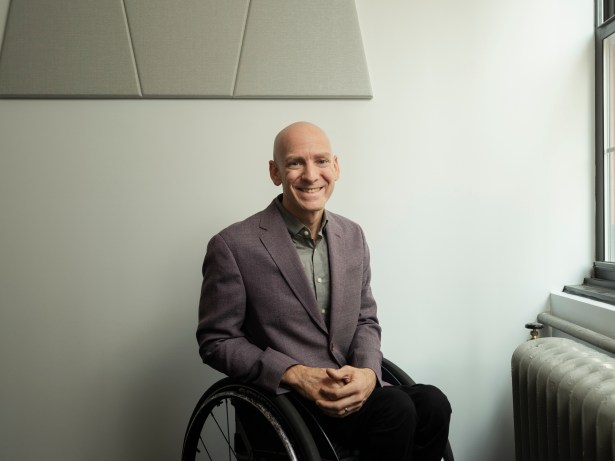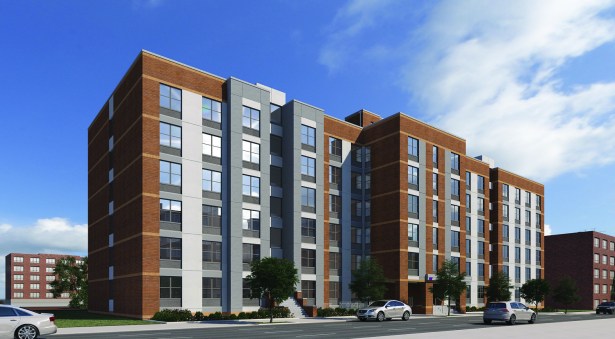Camber’s Rick Gropper on Affordable Housing in the Bronx
By Nicholas Rizzi September 10, 2019 12:00 pm
reprints
New York City landlords haven’t exactly been shy in stating their displeasure when it comes to the changes in affordable housing.
After the New York State legislature passed rent stabilization reforms in June aimed to better protect tenants, owners have repeatedly threatened to flee the city while others have intentionally left apartments empty to avoid locking in rents under the current law.
The goal of many landlords who buy buildings with rent-regulated apartments is to switch them to market rate, but Rick Gropper has done a rare thing: He’s developed a business at Camber Property Group going the other way.
“We’ve competed against buyers [who have] a business plan of buying the building, renovating units, increasing the rent as high as possible and displacing people,” said Gropper. “We kind of take the opposite approach. We’ve bought buildings that have no affordability and work with the city to structure a tax abatement, so we can cut the taxes down and then we’re able to restrict rents going forward.”

Gropper started his career at L+M Development Partners, one of the most prolific developers of multifamily housing in the city, which he joined in 2008 as an intern and eventually became a development director. He was responsible for the creation and preservation of more than 5,000 units of housing, totaling over $1 billion in total capitalization while at the firm.
Gropper co-founded Camber in 2016 with Andrew Moelis, whom he met through Moelis’ father, Ron, the co-founder of L+M. While Camber does build market-rate housing around the city, it mainly focuses on affordable projects, either from the ground up or in existing buildings. And it has been active in recent months, especially in the Bronx.
Camber kicked the year off picking up an 11-building, 343-unit portfolio in the West Farms neighborhood for $75 million, teaming up with Belveron Partners and the New York City Department of Housing Preservation and Development (HPD) to bring 100 market-rate apartments in the properties back to affordability.
In May, Camber cut the ribbon on two Longwood buildings — The Hemlock at 960 Simpson Street and The Mulberry at 1000 Fox Street — that added a total of 200 affordable units to the neighborhood. The next month, Camber partnered with Belveron again to buy the 400-unit Highbridge Houses at 1133 Ogden Avenue with plans to bring all apartments lost to vacancy decontrol back to regulation.

This activity comes after Camber closed on several sales in December 2018, including the purchase of a 50 percent stake in 722-units of public housing in the Bronx’s 14-building New York City Housing Authority’s Baychester and Murphy houses for $90 million as part of a joint venture with L+M and MBD Community Housing Corp.
“We’re replacing everything from roofs to boilers to kitchens to bathrooms,” he said. “[We’re] really thinking about holistically changing the look and feel of the complexes, so that the people who live there don’t live in public housing. They live in a place they can call home and that they’re proud of.”
All told, the company has either closed or is in construction on 4,000 units across the city, with a large chunk of them in the Bronx. The portfolio is a mix of new market-rate developments, new mixed-income ones and completely affordable properties.
“He really knows the business,” said Alan Weiner, the group head of Wells Fargo Multifamily Capital, who’s worked on multiple deals with Camber including the Baychester and Murphy houses purchase. “He’s very professional, the deals are done correctly. So, from the point of view of a lender and somebody who finances his deals, we really look forward to doing business with him.”
Weiner called Gropper a “delightful human being,” then lovingly added that, when it comes to closing deals, he can be a “relentless pain in the ass.”
“He wants to get his deal done and he wants to get his answers,” Weiner said. “He’s not an A-type [personality], he’s triple A. I always have to tell him to calm down.”
The 37-year-old has always been a driven person — competing in ski races and finishing the New York City Marathon twice — who said he tries not to let any obstacles get in his way.
He was born in New York City and grew up in Ridgewood, New Jersey, amid a family of avid skiers. On a family ski trip to Vermont in 1996, the car he was traveling in skidded on a patch of ice and hit a truck. The accident left the then 13-year-old Gropper paralyzed.
But it didn’t keep him off the mountain for long: The next year he started to learn to adaptive ski.
“I really liked it, it was like a new challenge and something that I could work towards to try to ski independently,” he said. “I’m a better skier now sitting down than I was standing up.”
He eventually got into competitive ski racing and had a plan to move to Colorado after college to focus on it full-time.
During one of the races, Gropper was contacted by a producer from MTV to appear on a reality show. The crew followed Gropper around races and on-campus at Connecticut College as he ran for school president. The show eventually aired on “True Life: I’m in a Wheelchair.”
Gropper said the show was a pretty good snapshot of his life at the time, and he hoped it conveyed a message about dealing with life’s challenges.
“I was thinking that it’s an opportunity to send a message to other people and show other people that if you’re in a wheelchair, or if you have a disability, or if there’s something that’s going on in your life that’s really bad, there’s no reason that you have to continue down that dark hole,” he said. “You can have choices, you have options. You can take something that might not seem good and turn it into an opportunity.”
Gropper was on a train into Manhattan when he had a chance encounter with a real estate professor from Columbia University. By then, Gropper had graduated from Connecticut College, discarded the professional skiing plans, and was working in fundraising while living in New Haven. The conversation with the professor peaked Gropper’s interest, enough that he applied to Columbia and was later accepted.
He graduated with a master’s in real estate development in 2008 and was able to land an internship at L+M despite the terrible job market. He immediately got assigned to work on the firm’s growing affordable housing division — eventually landing a full-time job after a year internship — where he developed a passion for the market.
Gropper — who lives in Midtown and has been married for six years — has had the itch to start his own company since he was young. He met Moelis, who was then working at Empire State Development, and the two shared a lot of the same real estate values. They eventually left their jobs to start Camber.
“We wanted to start from scratch,” Gropper said. “Build our company with our own values with our team.”
The company has steadily grown each year and currently employs about 15 people. It moved to new digs at 419 Park Avenue South last month to accommodate the growth.
“Rather than focusing on making every dollar on every project, we’re focusing on building good projects,” said Gropper. “Doing what we say we’re going to do and being a responsible member of the community in which we’re working.”
Even though affordable housing is Camber’s bread and butter, it has also worked on several market-rate projects around the city. Its first development was the six-unit condominium building at 64 East 1st Street in the Lower East Side, which was completed in 2017.
The company currently has a nine-story, 122-unit rental building under construction at 1881 Starr Street in Bushwick, Brooklyn, which will have 25 percent of its apartments set aside for affordable housing.
“We focused on creating a community in the building with enough amenity space and retail on the ground floor,” he said. “I think we’re going to attract the people that have been frequenting the bars and restaurants in Ridgewood, [Queens], and in Bushwick, who really want to move there and have a place that will have all of the amenities.”
But whether market-rate or affordable housing, Gropper said Camber brings the same mentality to each project of giving people comfortable places to live that will be a benefit for the neighborhood.
“The main thing that we’re focused on is just quality projects, both financially and physically,” he said. “Doing the right job is one of the most important things that we can do.”
Gropper said the company wants to be long-term owners and generally pumps money into all of its affordable housing projects. Sometimes that means simply beefing up security and upgrading the infrastructure, but other times it means a bit more care.
When Camber bought the two-building Carol Gardens complex in Soundview at 820 and 880 Thieriot Avenue for $19 million in 2017, the Mitchell-Lama buildings needed a lot of work to revitalize them.
“There were sidewalk bridges up around the building for years, there was an abandoned pool in the basement that was filled with water, and that pool was abandoned 40 years ago,” he said. “We filled it with concrete and closed it.”
It’s not just empty pools that can make affordable housing projects a headache. Camber has to review tax credits, subsidies, tax exemptions, taxes on bonds, and lenders to finance the purchase, all while working with city agencies and elected officials to sign off on them.
“Everyone, generally, wants to get the deal done,” he said. “It’s a question of how we get those 10 sources and 10 different competing needs and take that to a closing.”
Camber tends to avoid dealing with affordable housing subsidies for these deals and instead focuses on getting tax abatements from the city to make them financially viable.
HPD offers several types of tax incentives that can be granted for the creation or preservation of affordable housing, which include an abatement on taxes owed on rehabilitated buildings by applying credits based on the costs of improvements.
“We can reduce the taxes and still make a financially viable investment in a property with private [debt], with our own money and with conventional debt,” Gropper said. “Just using a tax abatement, we can do it in a way that’s financially viable and sustainable, but also created additional affordable housing.”
Gropper also has to be comfortable with shelling out millions of dollars on a down payment before getting the go-ahead from the city on its tax breaks for a project. But Gropper said his favorite part about real estate is problem-solving, and affordable housing has that in spades.
“That’s really what drives us,” he said. “To figure out what the goal is, what are the issues that are preventing us from getting to that goal? And how do we bring people together to solve them in a way that works for all the stakeholders?”
In the future, Gropper still sees value in buying buildings to bring them back to affordability, and he doesn’t expect that the rent reforms will impact its business model.
Camber was actually involved in some of the advocacy to get the rent reform bills passed. While Gropper said changes needed to be made, he worried that changing major capital improvements (MCIs) to drop off tenants’ rents after 30 years, instead of being built in as permanent rent increases, went too far and could be disastrous for the market.
“The result of rent reform is going to be disinvestment by some owners and their properties,” Gropper said.
So far, he’s seen prices on multifamily buildings with regulated apartments across the city decreased by 20 percent. And the bill made these properties that still have free market or preferential rental units more vulnerable to deregulation, so Camber has started to focus its energy on trying to pick up some of these.
“There is a real risk that those units are going to be turned to market and will be subject to market forces,” he said. “If we could buy some of those buildings that were either previously regulated in an affordable program or are currently free market, I think there’s an opportunity.”


